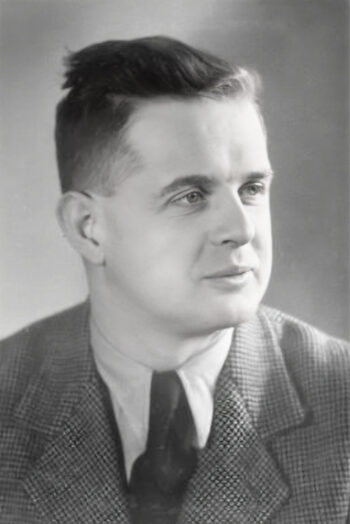Suchomel, Franz

Franz Suchomel (3 Dec. 1907 – 18 Dec. 1979), SS Unterscharführer, became a photographer at the Hadamar euthanasia institution in March 1941. In August, he was transferred to the Treblinka Camp, were he confiscated and inventoried the property brought in by Jewish deportees. In October 1943, he was briefly posted to the Sobibór Camp while its operations were suspended. He was put on trial in Düsseldorf, Germany, in 1965 for his involvement in the alleged activities at Treblinka. He was ultimately sentenced to six years imprisonment for aiding in mass murder.
Suchomel spoke out only almost 40 years after the event, after he had served his prison term and was then interviewed by Claude Lanzmann for his movie Shoah. Lanzmann later revealed how he persuaded alleged German perpetrators to agree to an interview with him: He created a fake ID and fake academic credentials for himself, invented a research association he claimed to work for that didn’t exist, forged letterheads of an institution that did exist, and paid every single one of the alleged perpetrators 3,000 deutschmarks for their interview (worth some 6,000 US dollars in 2023), plus had them sign an agreement not to reveal this fact.
However, in an article published by The New York Times on 20 October 1985 (p. H-17), Lanzmann claimed that the interview with Suchomel was filmed against Suchomel’s wish and without his knowledge with a camera hidden in a bag. But throughout the interview, the camera follows the actors repeatedly, and Suchomel looks into the camera on occasion when explaining things. The camera even follows his pointer stick in close-up motions across a large camp map when Suchomel explains things. It is evident from this that Suchomel knew that he was being recorded and where the camera was, and that someone made the camera move all the time, which would not have been possible, had the camera been hidden in a bag standing still somewhere nearby. Therefore, the entire interview was a charade.
Suchomel’s statements include three claims in particular which render his entire testimony even more suspicious:
- He insisted that, when the Germans decided to exhume some 700,000 corpses buried in mass graves, their Jewish work slaves “preferred to be shot rather than work there.” Considering that these work slaves are said to have been witnesses of the mass murder of their brethren by the Germans and their auxiliaries, and that they were certain to be killed sooner or later as well, such a reaction is the only one conceivable. However, this is not what the mainstream narrative tells us, which insists that the Jewish slave laborers didn’t resist or even actively helped the Germans mass murder their brethren and eliminate the traces of this heinous crime. Suchomel had more common sense than all orthodox scholars together, though, so he changed the story line by claiming that the German perpetrators had to do the exhumation and cremation work themselves. Lanzmann didn’t believe that and tried to correct Suchomel, but Suchomel insisted: “In that case, the Germans had to lend a hand.” Imagine a few dozen German SS men excavating 700,000 corpses, then building 700 huge pyres for a thousand corpses each – all by themselves and within just four months! An impossible task, for sure.
- Suchomel claimed that people were constantly shot at the edge of burning pits, and that the victims realized what was going on only after they had reached the pits. Yet any SS man standing at the edge of a blazing pit constantly shooting people would have been badly burned. Furthermore, the deportees slated for getting shot inevitably heard from the distance that people were constantly getting shot, and the flames and smoke of a blazing fire cannot be hidden either, so how would the SS have succeeded in making them walk up to this spot that was unapproachable for anyone already due to its heat? Another impossible task.
- In Suchomel’s story, the corpses thrown into the blazing fire pits burned almost without any fuel: “With rubbish, paper and gasoline, people burn very well.” Yet the self-immolation of human corpses is a myth far removed from reality. In fact, open-air incinerations of human corpses require huge amounts of fuel. Some garbage and paper, lit with gasoline, may be suitable to light and kindle proper fuel such as wood and coke, but would not do much of anything to veritable mountains of corpses.
For Suchomel, the impossible and surreal was real. (For more details, see Beaulieu 2003.)

You need to be a registered user, logged into your account, and your comment must comply with our Acceptable Use Policy, for your comment to get published. (Click here to log in or register.)